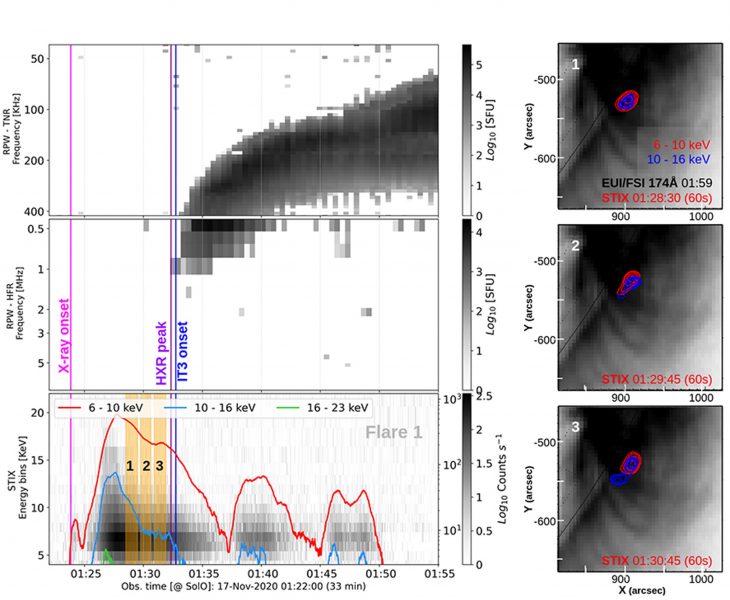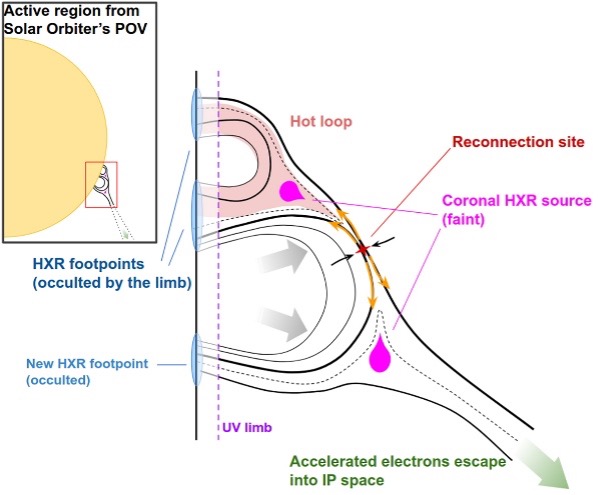Solar flares accelerate energetic electrons. While some of them escape into interplanetary space and produce interplanetary Type III solar radio bursts, the electrons interacting with the solar atmosphere produce Hard X-ray emission (HXR). Many studies relating the observations of type III radio bursts and HXR emissions have been performed since the first observations of their temporal association (e.g., Kane 1972, 1981). More recently, statistical studies were done by https://www.aanda.org/articles/aa/full_html/2025/02/aa52278-24/aa52278-24.html and James & Vilmer (2023) on the link between the electrons producing HXR emissions and the properties of coronal type III bursts and the association with interplanetary type III bursts. With STIX and RPW now observing continuously on the same spacecraft (Solar Orbiter), we are in a unique position to pursue the exploration of the association between HXR flares and interplanetary type III bursts.
The recent study by Paipa-Leon et al. (2025) is based on five days of observations (17 November- 21 November) in 2020, when STIX and RPW provided the first simultaneous observations of X-ray flares and type III radio bursts on Solar Orbiter (Figure 1).

Figure 1. RPW/STIX observations from November 18 at 00:00 UT to November 19 at 18:00 UT. (Top curve) From top to bottom: RPW-TNR (100–425 kHz) and RPW-HFR spectrograms (425 kHz- 8 MHz), and STIX count rate light curves. The vertical lines indicate the time of type III onsets. (Bottom curve) For six flares, X-ray contours overlaid on EUV images (EUI) in the 174 Å band. The color-coding of the energy band of the contours is the same as in the top panels.
Figure 1 shows that the association between the two types of emission is not one-to-one, as already known from previous studies. The strongest X-ray flare detected up to 80 keV has no type III counterpart. The most intense IP type III burst (event 8) is associated to a relatively weak flare (no counts above 16 keV). During the whole period of observations, 21 IP type III bursts and HXR flares were found to be temporally associated (with a total of 232 HXR flares observed by STIX and 32 IP type III bursts observed by RPW).

Figure 2: Event on November 17 ∼ 01:25 UT. (Left from top to bottom): RPW spectrograms and STIX count rate spectrogram and light curves in different energy ranges overlayed. The X-ray flare onset time, the IP type III burst onset time and the time of the associated X-ray peak are marked with vertical lines in magenta, blue, and purple. (Right) X-ray contours at selected time intervals overlaid on the EUI/FSI image in the 174 Å band.
Figure 2 shows that the onset of IP type III burst is not necessarily associated with the first HXR peak of the flare nor the most energetic one, but it may be associated with later peaks. This is the case for most of the flares of our sample. Only in six cases is the IP type III burst temporally associated with the main HXR peak. The delays between the onset of IP type III bursts and the time of associated HXR peaks vary from a few seconds up to around five minutes, with most of them under three minutes. These delays are consistent with the propagation time of electrons with velocities around 0.1 c (typical of electrons producing type III bursts) between the injection time from the low corona to the place where they can produce radio emissions in the frequencies range from 6.52 MHz to 675 kHz). Figure 2 (right) also shows that changes in the morphology of HXR sources are observed close to the onset of IP type III bursts. This is observed in all flares of our sample. Either additional X-ray sources appear near pre-existing X-rays sources on the disk or at the limb (see figure 2b) or an elongation of the X-ray source is observed when the active region is behind the limb (see flares 12 and 13 in figure 1).
Conclusions
Figure 3 describes a possible scenario to explain the appearance of new X-ray sources or elongation of X-ray sources for flares close to the limb. Successive reconnection episodes produce energetic electrons in magnetic configurations with different connectivity to the upper solar atmosphere. A first reconnection event occurs in the low corona and produces HXR emitting energetic electrons. This first episode is not associated with a radio burst since energetic particles have no access to open field lines. As the magnetic configuration evolves, a new reconnection event occurs higher in the corona between closed and open field lines. Some accelerated electrons produce X-rays and some of them propagate in the open field line and produce type III bursts. If the flaring active region is still on the disk, the new reconnection event leads to the appearance of new footpoints. Faint coronal sources may also be produced at the loop-tops near the reconnection sites. When the footpoints are occulted (active region close to the limb or behind), these coronal sources can be detected and new sources appearing higher in the corona can be observed in connection with the new reconnection episode. Given the limited spatial resolution or long integration times, the appearance of the new coronal source can appear as an elongation.
Our results confirm the significant role of interchange reconnection in the access of flare-accelerated electrons to open magnetic field lines, as previously in e.g. Krucker et al., 2008.

Figure 3: Cartoon for the proposed reconnection scenario (adapted from Glesener et al. 2012). Energy release is triggered by an emerging loop in the active region embedded in open field lines. Reconnection occurs between the closed rising loop and the open magnetic field line. Energetic electrons traveling along the reconnected field lines (orange arrows) produce hard X-ray emissions at footpoints (in blue; they can be occulted if the active region is behind the limb) and in coronal sources (in magenta) close to the reconnection site (in red). They can also escape along the open magnetic field line in the corona toward the IP medium and produce type III bursts (in green).
Based on the recent paper by Paipa-Leon, D., et al. Connecting energetic electrons at the Sun and in the heliosphere through X-ray and radio diagnostics, Astronomy & Astrophysics, Volume 694, id.A111, DOI: 10.1051/0004-6361/202452278
References
Glesener, L., Krucker, S., & Lin, R. P. 2012, ApJ, 754, 9
James, T., & Vilmer, N. 2023, A&A, 673, A57
Kane, S. R. 1972, Sol. Phys., 27, 174
Kane, S. R. 1981, ApJ, 247, 1113
Krucker, S., Saint-Hilaire, P., Christe, S., et al. 2008, ApJ, 681, 644
